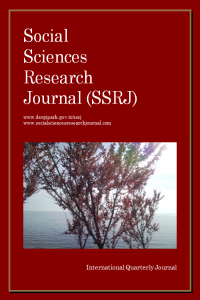Türkiye’de İstihdam Oranının Box-Jenkins Tekniği Kullanılarak Modellenmesi ve Orta Dönem Öngörüsü
İstihdam Oranı, Mevsimsellik, ARIMA Modelleri, Öngörü
Box-Jenkins technique of Employment Rate in Turkey Using Modeling and Mid-Term Forecasting
Employment Rate, Seasonality, ARIMA Models, Forecasting,
___
- Adhikari, R. and Agrawal, R. K. (2013). An Introductory Study on Time Series Modeling and Forecasting. LAP Lambert Academic Publishing.
- Akgül, I., (2003). Zaman Serilerinin Analizi ve ARIMA Modelleri. 1.Edition. İstanbul: DER Publishing.
- Altuntepe N., ve Güner T. (2013). Türkiye’de İstihdam-Büyüme İlişkisinin Analizi (1988-2011), Uluslararası Alanya İşletme Fakültesi Dergisi International Journal of Alanya Faculty of Business 5.1, 73-84.
- Beaulieu, J.J., and Miron, J.A. (1993). Seasonal Unit Roots in Aggregate U.S. Data. Journal of Econometrics. 55, 305-328.
- Box, G.E.P., G.M. Jenkins, G.C. Reinsel, and G.M. Ljung. (2016). Time Series Analysis: Forecasting and Control. 5.Edition. New Jersey: John Wiley&Sons, Inc.
- Curry, B. (2007). Neural Networks and Seasonality: Some Technical Considerations. European Journal of Operations Research. 179, 267-274.
- Dritsaki, C. (2016). Forecast of Sarima Models: Αn Application to Unemployment Rates of Greece. American Journal of Applied Mathematics and Statistics. 4-5, 136-148.
- Ette H., Uchendu B, and Uyodhu V. (2012). Arima Fit to Nigerian Unemployment Data. Journal of Basic and Applied Scientific Research. 2.6, 5964-5970.
- Fuchs, J., Sihnlein, D., Weber, B., Weber, E. (2018). Stochastic Forecasting of Labor Supply and Population: An Integrated Model. Population Research and Policy Review. 37.1, 33-58.
- Gujarati, D. (2005). Basic Econometrics. 3. Edition. The McGraw-Hill Companies.
- Hahn, H., Meyer-Nieberg, S., and Pickl, S. (2009). Electric Load Forecasting Methods: Tools for Decision Making, European Journal of Operational Research, In press. 199, 902-907.
- Hylleberg S., R.F. Engle, C.W.J. Granger ve B.S. Yoo. (1990). Seasonal Integration and Cointegration. Journal of Econometrics. 44, 215-238.
- Ion, D., and Andriana, A. (2008). Modeling unemployment Rate Using Box-JienkingsProcedure. Journal of Applied Quantitative Methods. 3.2, 156-166.
- Karaali F. Ç. (2006). Use of Artificial Neural Networks and Cognitive Mapping Methodology in Predicting Unemployment Rates and Employment Index Level. Unpublished Ph.D. Thesis. İstanbul Technical University Institute of Science and Technology.
- Li T., Corcoran J., Pullar D., Robson A., Stimson R. (2009). A Geographically Weighted Regression Method to Spatially Disaggregate Regional Employment Forecasts for South East Queensland. Applied Spatial Analysis and Policy. 2.2, 147-175.
- Muratoğlu Y. (2011). Büyüme ve İstihdam Arasindaki İlişki: Türkiye Örneği. International Conference On Eurasian Economies.
- Nelson, M., Hill, T., Remus, W., O’Connor, M. (1999). Time Series Modelling Using Neural Networks: Should the Data Be Deseasonalized First?. Journal of Forecasting. 18, 359-367.
- Nickell, S. (1984). An Investigation of the Determinants of Manufacturing Employment in the United Kingdom. The Review of Economic Studies. 51.4, 529-557.
- Power, B., and Gasser, K. (2012). Forecasting Future Unemployment Rates. ECON 452 First Report.
- TURKSTAT, https://biruni.tuik.gov.tr/medas/?kn=72&locale=en, 10.07.2019.
- Witt S. F., Song H., Wanhill S. (2004). Forecasting Tourism-Generated Employment: The Case of Denmark, Tourism Economics. 10.2, 167–176.
- Yayın Aralığı: Yılda 4 Sayı
- Yayıncı: Denta Florya ADSM Limited Company
Covid-19 Bağlamında Devletlerin Hak ve Sorumlulukları
Toplum 5.0: Süper Akıllı Toplum
Türkiye’deki Özel Bankaların TOPSİS Yöntemiyle Performans Analizi
Sürdürülebilir Atık Yönetimi Uygulamalrında Dünya ve Türkiye Karşılaşması: EDİKAB Örneği
Meslek Yüksekokulu Öğrencilerinin Uzaktan Eğitimi Tercih Nedenleri ve Beklentileri
Covıd-19 Salgınının Tüketicilerin Online Alışveriş Tercihine Etkisi
İller Arası Ticaretin Belirleyicileri: Tekirdağ İli Örneği
Türkiye’de İstihdam Oranının Box-Jenkins Tekniği Kullanılarak Modellenmesi ve Orta Dönem Öngörüsü
Gözde BOZKURT, Turgut ÜN, Yasemin BAKSİ, Mücella ŞAHİN
Tık Odaklı Habercilikte “Tık Yemi” Taktiği: Koronavirüs (Kovid-19) Örneği
Okul Dışı Öğrenme Ortamlarına Yönelik Sınıf Öğretmenlerinin Görüşleri: Kayseri Bilim Merkezi
